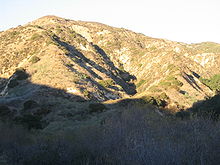Santa Susana Mountains
Snow falls in winter in some higher areas, such as Oat Mountain, but melts quickly.
4 has the distinction of being the first site in Los Angeles County to be listed on the National Register of Historic Places, in 1966.
The largest of SoCalGas's four underground storage natural gas facilities is within the Aliso Canyon Oil Field north of Porter Ranch.
The City of Los Angeles maintains O'Melveny Park at the eastern end of the mountains.
Spring wildflowers include the redbush monkey flower, Mariposa lily, and canyon sunflower.
Perhaps the most common raptors observed soaring over the brushy, boulder-strewn landscape are turkey vultures, red-tailed hawks, and American kestrels.
Streams and creeks support populations of Pacific tree frog, the small amphibian whose signature chorus adds an aura of mystery and inexplicable beauty to the surrounding land.
Western toads often make their appearance at nightfall, emerging from burrows in search of water and insects, while California slender salamanders are often found under the cool leaf litter and canopy of oak woodlands.
Mammals that may be regularly observed in the mountains include smaller animals such as the California ground squirrel and brush rabbit.
As for larger mammals, the well-trained eye might spot California mule deer or a coyote.
Larger mammals that are considerably more secretive and therefore less often encountered include the gray fox, bobcat, ring-tailed cat, American badger, and the mountain lion.
[4] A population of American black bears occupy various niches in the backcountry; showing up in communities below the mountains every few years.


